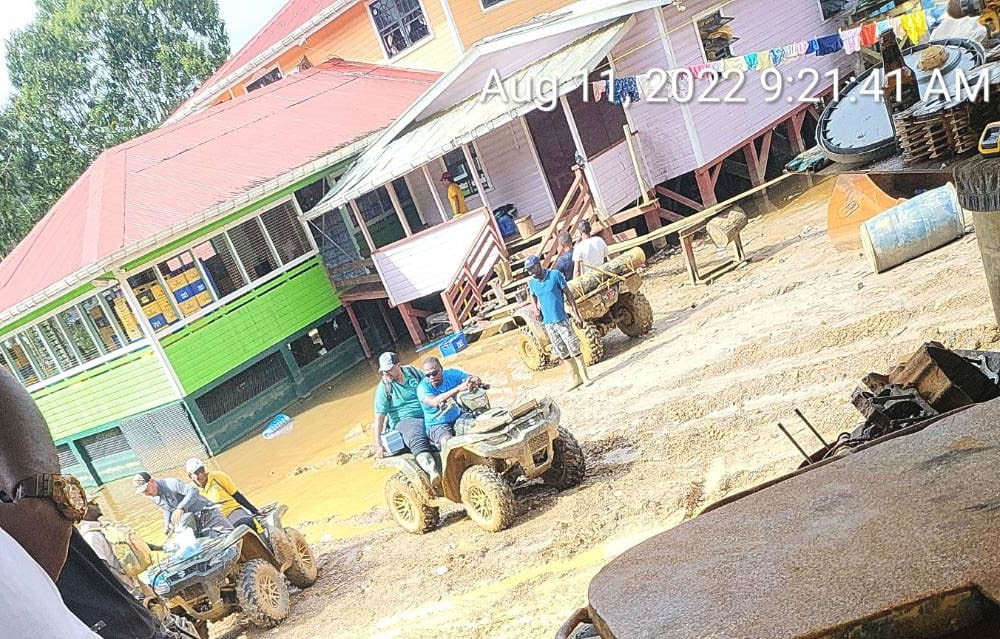After indicating that they prefer to work alone to avoid a conflict of interest, officers from the GGMC as well as the Environmental Protection Agency (EPA) investigating mining operations in Chinese Landing were seen being transported by the same miners against whom reports of violations have been made, according to Toshao Orin Fernandes.
On Wednesday, three officers from the Guyana Geology and Mines Commission (GGMC) and two from the EPA ventured to Chinese Landing where they met with Fernandes. The team informed him that they are in the community responding to “a report in the newspaper.”
The village leader reported that he asked the officers whether the Village Council can accompany them to the mines, but was told that “they prefer to do it officially[and] them ain’t want the miners to feel they picking sides and the whole thing about avoiding conflicts and so.”
At that time, he pointed out that the team was being transported in boats belonging to miners operating in the Tassawini area.
Yesterday, the team travelled to the mines where they were expected to address the numerous alleged violations. However, Fernandes said that it was observed that the officers were being transported, again, by miners operating in the Tassawini mines.
He added that the officers did not indicate that their investigation has been completed nor did they say if they are leaving the community. However, he did raise questions about the quality of the investigation that will be conducted given the fact that the officers seem to be working in close partnership with the same miners they are investigating.
Last week Stabroek News travelled to the community where it was related that approximately 500 miners are occupying the mining blocks within the community, threatening both the health and livelihood of the community members. On its visit to the mines, this newspaper observed that the deepest mining pit is approximately 500 ft deep – which is no longer considered sub-surface mining.
Fernandes accompanied this newspaper to the pit and he was shocked by the devastation. What also stood out was the fact that the toshao had to seek permission to visit the mines from the operators there although it falls within the community. Fernandes explained that it was necessary since the miners had threatened them with prosecution for trespassing on several occasions.
The road leading to the mines has severely deteriorated and according to the Village Council, the residents had been maintaining it because neither Vieira nor the government is interested in doing so.
Also, the environmental impacts of mining at Tassawini are visible. The miners there are using mercury to extract the gold and it is released into the Tassawini Creek, which flows into the savannahs and into Huri Creek.
“…the tailing [residue from mercury] runs into our big savannah and spread in to there and then it run into the Tassawini Creek and then the Tassawini Creek runs straight into Huri Creek. This Huri Creek is our natural boundary, it runs all the way back to Kariako and then it comes into Barama. So the tailing whatever you use there it has to run into Huri Creek even if you bar it off and it break away it runs straight into Huri Creek and into Barama,” Fernandes had said.
Those creeks and the savannah are the fishing grounds for Chinese Landing people as well as their main water sources. Now they are forced to look at alternatives owing to the pollution from mining. Fernandes had tested for above-normal levels of mercury in his system and had to undergo treatment.
Chinese Landing, a Carib indigenous community, is a remote village along the Barama River in the Barima-Waini region and it received its land title in 1976 under then Prime Minister Forbes Burnham. The village received its Certificate of Title on August 10, 2018, for 30.06 square miles or 19,241 acres of land.
The issue in the village stems from a 1995 allocation of mining blocks within the community’s titled lands. The miners currently occupy a section of the village called Tassawini – the gold-rich area. That area has been allocated to Wayne Vieira, a businessman from Houston, East Bank Demerara. The village has said that it was done without their free, prior and informed consent.
The Tassawini area was where villagers used to mine and with the allocation of the blocks to a Georgetown-based businessman, Chinese Landing residents could not have earned a living anymore.
The community also approached the United Nations Committee on the Elimination of Racial Discrimination (UN CERD) and complained about a number of violations under the Amerindian Act. UN CERD has since written to the government highlighting several rights violations and urged the government to take immediate steps to remedy the situation.





